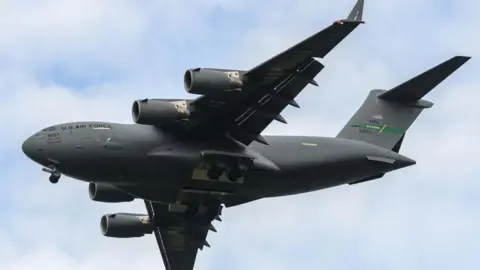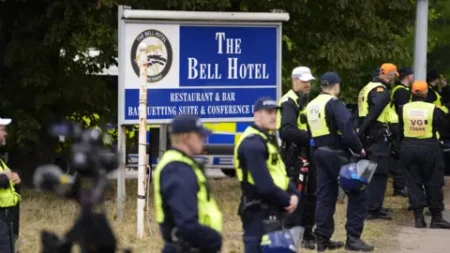Amid increasing tensions and speculations regarding nuclear weapon deployment, campaigners have raised an urgent call for government transparency following reports that the United States Air Force has relocated nuclear weapons to a Suffolk airbase. This has ignited concerns over the management of nuclear capabilities and the need for clarity surrounding military operations that have far-reaching implications for regional and international security.
The catalyst for this discussion emerged when flight tracking data revealed that a C-17A Globemaster III, a specialized military transport aircraft known for its capacity to carry heavy loads, flew over 4,400 miles (approximately 8,200 kilometers) from New Mexico to RAF Lakenheath in Suffolk. This development has led the Campaign for Nuclear Disarmament (CND) to demand that Prime Minister Keir Starmer make a formal statement regarding the potential deployment of these weapons, asserting that it is vital for the public to be informed about such significant military movements.
Despite these concerns, both the U.S. Air Force (USAF) and the UK Ministry of Defence have refrained from commenting on the deployment of nuclear weapons. This veil of silence has heightened public anxiety and calls for increased accountability and transparency in nuclear arms management. The CND emphasized that the implications of nuclear armament on British soil should not be borne by the civilian population through secondary reports, urging the government to ensure openness about any significant changes in national security policies.
In the backdrop of these developments, previous indications from the US Department of Defence had already suggested that RAF Lakenheath was preparing to receive nuclear ordnance. Reports had surfaced regarding contracts for constructing defensive shelters intended for the base’s anticipated nuclear mission, which were subsequently withdrawn for unspecified reasons. If these developments are confirmed, it would mark the first instance since 2008 that nuclear weapons are stationed at Lakenheath—a military base traditionally housing the 48th Fighter Wing, known as the Liberty Wing.
The presence of the F-35A Lightning II jets at Lakenheath, which have been successfully tested to carry the B61-12 thermonuclear bomb—designed for tactical battlefield use—further complicates the military landscape. The aircraft are part of a broader strategy involving nuclear deterrence in the evolving geopolitical climate.
Further emboldening suspicions regarding the recent flight of the C-17A was analysis from William Alberque, a former NATO arms control expert. He stated that all indications pointed towards the cargo of the aircraft being B61-12 nuclear bombs based on circumstantial evidence gathered from the flight. Notably, the C-17’s transponder was activated at a “hot weapons” pad, which is an unusual practice unless carrying sensitive or dangerous material. The transponder’s signals also confirmed air refueling occurring over the Atlantic, suggesting premeditated planning in the transport of the aircraft and its payload.
Fellow aviation analyst Roger Smith corroborated that the C-17A, which had originally departed from McChord Air Force Base in Washington State, used identification codes typically associated with specialized missions involving nuclear transport. He described how the callsign also links to the Prime Nuclear Airlift Force (PNAF)—a dedicated group responsible for the aerial movement of nuclear weapons.
As concerns regarding the stationing of nuclear weapons at RAF Lakenheath reach new heights, the CND continues to demand that the government not only acknowledges the developments but also engages in an open discussion within Parliament. Chairman Tom Unterrainer criticized the lack of transparency, emphasizing that such critical national security issues should not remain obscured from public discourse.
In response to the pressing issues raised by these uncertainties, a spokesperson from the Ministry of Defence reiterated a long-standing policy of neither confirming nor denying the presence of nuclear weapons at any given location. A similar sentiment was echoed by a US Department of Defense official for consistency across military policy regarding nuclear assets.
In light of the complexities surrounding nuclear deterrence and regional security, the discussions initiated by the movement of military assets continue to highlight the need for an informed and engaged public in matters concerning national defense and military operations.











